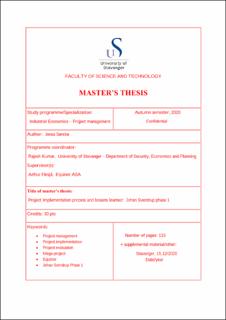| dc.description.abstract | Previous projects on the Norwegian Continental Shelf have had a history of budget overruns and delays. History seems to be repeated in recent years with field developments such as Martin Linge and Johan Castberg. In the same period, Johan Sverdrup, one of the largest field developments in recent years, has been delivered before time, well under budget and with good HSE results. Is this just a coincidence? Or is it possible to learn something from the project implementation?
This thesis aims to assess the project implementation of Johan Sverdrup phase 1. The project's different phases will be discussed, focusing on defining factors such as the project culture, ambitious targets, close follow-up and early involvement. In this process it is desired to identify success and improvement factors, and to determine if these factors are transferrable to new field developments on the Norwegian Continental Shelf.
During the writing of this thesis, data has been gathered through interviews with project participants, experience reports, and summary papers from the project management team. This information has then been analyzed and compared to find the key drivers to the project's success, what the project could have done better, and what we can learn from the project implementation.
Johan Sverdrup started construction in a favorable market. Being countercyclical gave them the capacity they needed and more favorable prices on the contracts. This saved costs and gave them access to competent contractors, engineers, and skilled workers. However, this is not the only reason the project became a success. Factors contributing to a successful project implementation are: A project culture built on openness and collaboration, the contract and contractor combinations, ambitious goals and aggressive targets, close follow up and early involvement, operational involvement, safety at worksites, project control, and strong and clear leadership.
Although the project had success in these areas, there are still some areas that could have improved the project implementation. Late changes during concept selection meant that the concept was not matured enough going into the FEED. The complexity of new technology or new products was underestimated and not adequately communicated, and experience transfer and feedback from the delivered product have improvement potential.
Johan Sverdrup has shown us the importance of ambitious goals and aggressive targets, that a project culture around openness and collaboration is vital, and that close follow up and early involvement is required to ensure timely delivery with the right quality. Maturing the concept through the FEED, and protecting layout and design through the project execution, is equally important. Furthermore, HSE should always have the highest priority. This learning should be transferrable to other projects, but it requires contracts that enable collaboration, good leaders, and adequate resources. | en_US |
